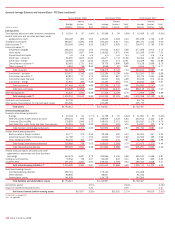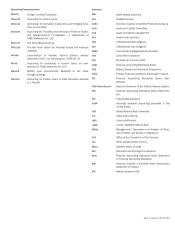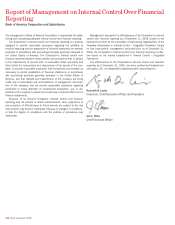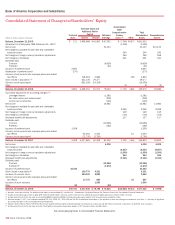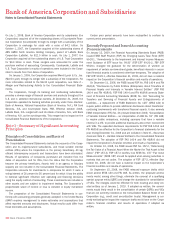Bank of America 2008 Annual Report Download - page 122
Download and view the complete annual report
Please find page 122 of the 2008 Bank of America annual report below. You can navigate through the pages in the report by either clicking on the pages listed below, or by using the keyword search tool below to find specific information within the annual report.Bank of America Corporation and Subsidiaries
Notes to Consolidated Financial Statements
On July 1, 2008, Bank of America Corporation and its subsidiaries (the
Corporation) acquired all of the outstanding shares of Countrywide Finan-
cial Corporation (Countrywide) through its merger with a subsidiary of the
Corporation in exchange for stock with a value of $4.2 billion. On
October 1, 2007, the Corporation acquired all the outstanding shares of
ABN AMRO North America Holding Company, parent of LaSalle Bank
Corporation (LaSalle), for $21.0 billion in cash. On July 1, 2007, the
Corporation acquired all the outstanding shares of U.S. Trust Corporation
for $3.3 billion in cash. These mergers were accounted for under the
purchase method of accounting. Consequently, Countrywide, LaSalle and
U.S. Trust Corporation’s results of operations were included in the Corpo-
ration’s results from their dates of acquisition.
On January 1, 2009, the Corporation acquired Merrill Lynch & Co., Inc.
(Merrill Lynch) through its merger with a subsidiary of the Corporation. For
more information related to the Merrill Lynch acquisition, see Note 2 –
Merger and Restructuring Activity to the Consolidated Financial State-
ments.
The Corporation, through its banking and nonbanking subsidiaries,
provides a diverse range of financial services and products throughout the
U.S. and in selected international markets. At December 31, 2008, the
Corporation operated its banking activities primarily under three charters:
Bank of America, National Association (Bank of America, N.A.), FIA Card
Services, N.A. and Countrywide Bank, FSB. Effective October 2008,
LaSalle Bank, N.A. merged with and into Bank of America, N.A., with Bank
of America, N.A. as the surviving entity. This merger had no impact on the
Consolidated Financial Statements of the Corporation.
Note 1 – Summary of Significant Accounting
Principles
Principles of Consolidation and Basis of
Presentation
The Consolidated Financial Statements include the accounts of the Corpo-
ration and its majority-owned subsidiaries, and those variable interest
entities (VIEs) where the Corporation is the primary beneficiary. All sig-
nificant intercompany accounts and transactions have been eliminated.
Results of operations of companies purchased are included from the
dates of acquisition and for VIEs, from the dates that the Corporation
became the primary beneficiary. Assets held in an agency or fiduciary
capacity are not included in the Consolidated Financial Statements. The
Corporation accounts for investments in companies for which it owns a
voting interest of 20 percent to 50 percent and for which it has the ability
to exercise significant influence over operating and financing decisions
using the equity method of accounting. These investments are included in
other assets and are subject to impairment testing. The Corporation’s
proportionate share of income or loss is included in equity investment
income.
The preparation of the Consolidated Financial Statements in con-
formity with accounting principles generally accepted in the United States
(GAAP) requires management to make estimates and assumptions that
affect reported amounts and disclosures. Actual results could differ from
those estimates and assumptions.
Certain prior period amounts have been reclassified to conform to
current period presentation.
Recently Proposed and Issued Accounting
Pronouncements
On January 12, 2009, the Financial Accounting Standards Board (FASB)
issued FASB Staff Position (FSP) No. Emerging Issues Task Force (EITF)
99-20-1, “Amendments to the Impairment and Interest Income Measure-
ment Guidance of EITF Issue No. 99-20” (FSP EITF 99-20-1). FSP EITF
99-20-1 changed the guidance for the determination of whether an
impairment of certain non-investment grade, beneficial interests in securi-
tized financial assets is considered other-than-temporary. The adoption of
FSP EITF 99-20-1, effective December 31, 2008, did not have a material
impact on the Corporation’s financial condition and results of operations.
On December 11, 2008, the FASB issued FSP No. FAS 140-4 and FIN
46(R)-8, “Disclosures by Public Entities (Enterprises) about Transfers of
Financial Assets and Interests in Variable Interest Entities” (FSP FAS
140-4 and FIN 46(R)-8). FSP FAS 140-4 and FIN 46(R)-8 amends State-
ment of Financial Accounting Standards (SFAS) No. 140 “Accounting for
Transfers and Servicing of Financial Assets and Extinguishments of
Liabilities – a replacement of FASB Statement No. 125” (SFAS 140) to
require public entities to provide additional disclosures about transferors’
continuing involvements with transferred financial assets. It also amends
FASB Interpretation (FIN) No. 46 (revised December 2003) “Consolidation
of Variable Interest Entities – an interpretation of ARB No. 51” (FIN 46R)
to require public enterprises, including sponsors that have a variable
interest in a VIE, to provide additional disclosures about their involvement
with VIEs. The expanded disclosure requirements for FSP FAS 140-4 and
FIN 46(R)-8 are effective for the Corporation’s financial statements for the
year ending December 31, 2008 and are included in Note 8 – Securitiza-
tions and Note 9 – Variable Interest Entities to the Consolidated Financial
Statements. The adoption of FSP FAS 140-4 and FIN 46(R)-8 did not
impact the Corporation’s financial condition and results of operations.
On October 10, 2008, the FASB issued FSP No. 157-3, “Determining
the Fair Value of a Financial Asset When the Market for That Asset Is Not
Active” (FSP 157-3). FSP 157-3 clarifies how SFAS No. 157 “Fair Value
Measurements” (SFAS 157) should be applied when valuing securities in
markets that are not active. The adoption of FSP 157-3, effective Sep-
tember 30, 2008, did not have a material impact on the Corporation’s
financial condition and results of operations.
On September 15, 2008, the FASB released exposure drafts which
would amend SFAS 140 and FIN 46R. As written, the proposed amend-
ments would, among other things, eliminate the concept of a qualifying
special purpose entity (QSPE) and change the standards for consolidation
of VIEs. The changes would be effective for both existing and newly cre-
ated entities as of January 1, 2010. If adopted as written, the amend-
ments would likely result in the consolidation of certain QSPEs and VIEs
that are not currently recorded on the Consolidated Balance Sheet of the
Corporation (e.g., credit card securitization trusts). Management is cur-
rently evaluating the impact the exposure drafts would have on the Corpo-
ration’s financial condition and results of operations if adopted as
written.
120
Bank of America 2008


